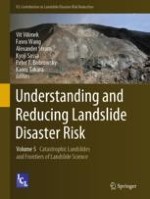2021 | OriginalPaper | Chapter
Extreme Rainfall Induced Landslide Susceptibility Assessment Using Autoencoder Combined with Random Forest
Authors : Kounghoon Nam, Fawu Wang
Published in: Understanding and Reducing Landslide Disaster Risk
Publisher: Springer International Publishing
Activate our intelligent search to find suitable subject content or patents.
Select sections of text to find matching patents with Artificial Intelligence. powered by
Select sections of text to find additional relevant content using AI-assisted search. powered by
